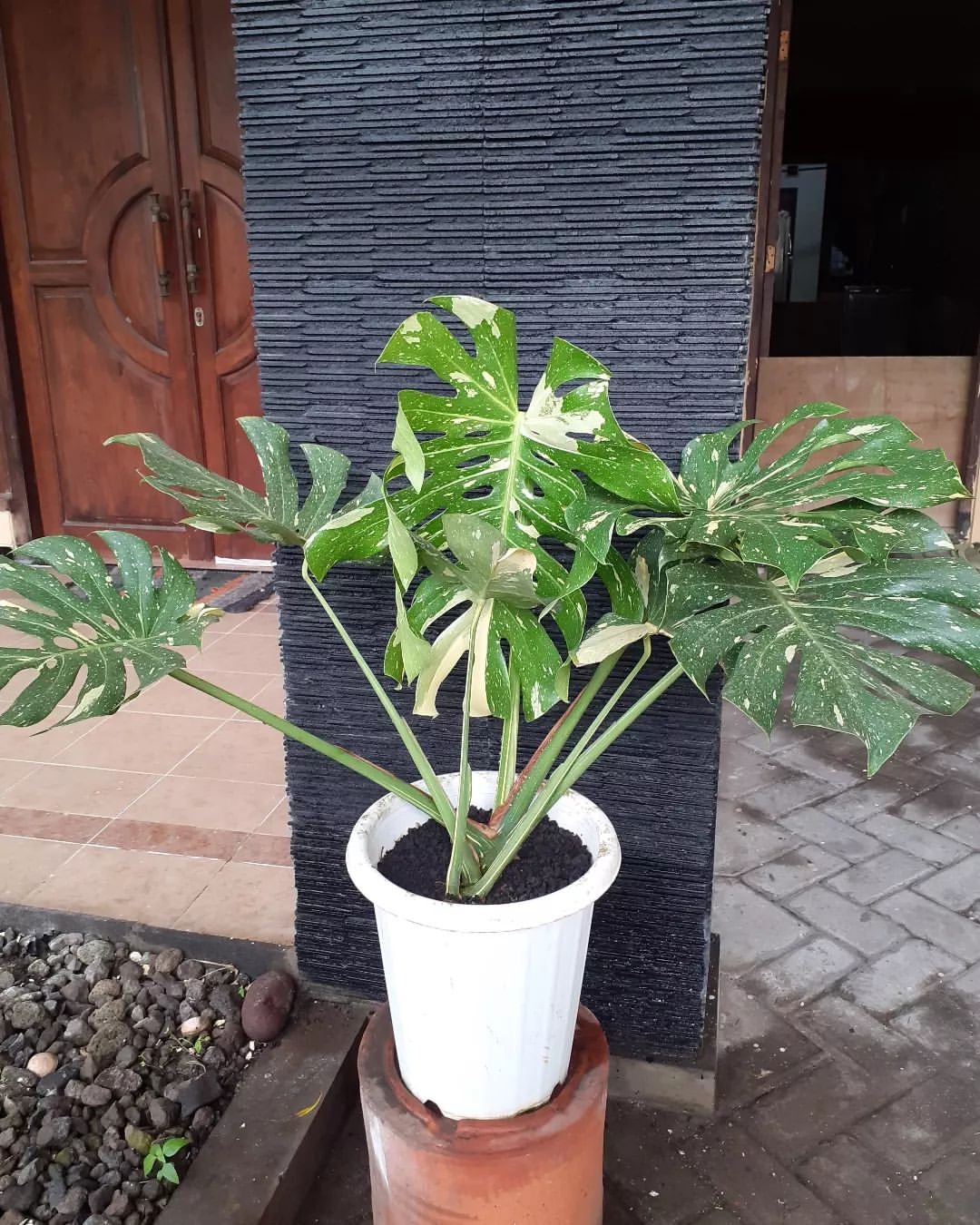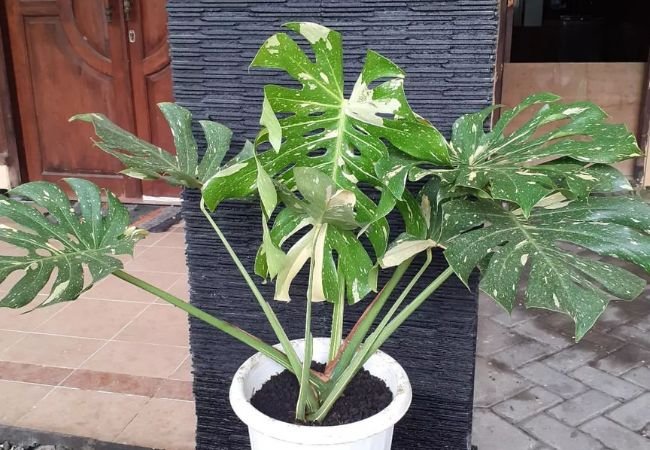Explore essential care tips and tricks for beginners to grow and maintain Thai Constellation Monstera plants successfully. Discover watering schedules, lighting needs and propagation techniques to nurture your unique indoor garden centerpiece.
Are you ready to add a touch of starry elegance to your indoor garden? Look no further than the Thai Constellation Monstera! This stunning plant, with its splashed white variegation, is taking the plant world by storm. But don’t worry if you’re new to plant care – we’ve got you covered with all the tips and tricks you need to help your Thai Constellation thrive.
Here’s the short information chart for the Thai Constellation Monstera:
| Aspect | Information |
|---|---|
| Botanical Name | Monstera deliciosa ‘Thai Constellation’ |
| Common Name | Thai Constellation Monstera |
| Plant Type | Tropical Vine |
| Zones | USDA Zones 10-12 (outdoors); typically grown indoors |
| Sun Exposure | Bright, indirect light |
| Soil Type | Well-draining, rich soil |
| Watering | Moderate; allow topsoil to dry slightly between waterings |
| Growth Habit | Climbing vine, can be trained as a houseplant |
| Height/Spread | Up to 6-8 feet tall indoors; spreads wide with aerial roots |
| Special Features | Variegated leaves with creamy splashes and marbling; highly sought after for its unique appearance |
What is a Thai Constellation Monstera?

Let’s start with the basics. The Thai Constellation Monstera is a variegated variety of the popular Monstera deliciosa. It’s known for its large, split leaves decorated with creamy white splotches that look like a starry night sky – hence the “constellation” in its name.
Unlike its wild cousin, the Thai Constellation is a man-made cultivar. It was developed in a lab in Thailand (that’s where the “Thai” part comes from) using tissue culture. This means every Thai Constellation is genetically identical, which is pretty cool when you think about it!
According to the University of Florida’s IFAS Extension, Monsteras are part of the Araceae family, which includes many popular houseplants. The Thai Constellation shares many care needs with its green relatives, but with a few important differences we’ll dive into.
Why Choose a Thai Constellation Monstera?
- Unique Appearance: The creamy variegation is stable and won’t revert, unlike some other variegated plants.
- Relatively Easy Care: While it needs some specific care, it’s not as fussy as some rare plants.
- Slow Growing: Perfect for those who don’t want a plant that outgrows their space quickly.
- Conversation Starter: Its unique look is sure to catch everyone’s eye!
Now, let’s get into the nitty-gritty of caring for your Thai Constellation Monstera.
Light Requirements
Your Thai Constellation Monstera loves bright, indirect light. This is crucial for maintaining its beautiful variegation. But be careful – direct sunlight can burn those delicate leaves!
Here’s a quick guide:
- Best: Near a north or east-facing window
- Good: A few feet away from a south or west-facing window
- Avoid: Direct sunlight, especially during the hottest parts of the day
According to the Clemson Cooperative Extension, most indoor plants, including Monsteras, prefer light intensities between 500 and 1,000 foot-candles. You can use a light meter app on your smartphone to check your plant’s spot.
Watering Your Thai Constellation
When it comes to watering, the Thai Constellation Monstera likes to be kept evenly moist, but not soggy. Here’s a simple watering routine:
- Check the top 2-3 inches of soil with your finger.
- If it’s dry, it’s time to water.
- Water thoroughly until you see it draining from the bottom of the pot.
- Empty the drainage tray to prevent root rot.
Remember, variegated plants often need less water than their all-green counterparts. The white parts of the leaves don’t photosynthesize, so the plant uses less water overall.
The University of Maryland Extension suggests that most indoor plants prefer to dry slightly between waterings. This is especially true for Thai Constellation Monsteras, which are prone to root rot if overwatered.
Soil and Potting
Your Thai Constellation Monstera will thrive in well-draining, nutrient-rich soil. Here’s a simple DIY mix you can try:
- 1 part regular potting soil
- 1 part perlite or pumice
- 1 part orchid bark
This mix provides the perfect balance of moisture retention and drainage that your Thai Constellation needs.
When it comes to pots, choose one with good drainage holes. Terracotta pots are great as they allow excess moisture to evaporate through the sides.
The North Carolina State Extension provides excellent information on container gardening, including soil mixes and pot selection for indoor plants like the Thai Constellation Monstera.
Humidity and Temperature
Thai Constellation Monsteras love humidity! They’re tropical plants, after all. Aim for humidity levels around 60-80%. If your home is dry, try these tricks:
- Use a pebble tray filled with water under the pot
- Group your plants together
- Use a humidifier near your plant
As for temperature, keep your Thai Constellation between 65-85°F (18-29°C). Avoid cold drafts and sudden temperature changes.
The University of Vermont Extension offers great insights into creating the right environment for tropical houseplants like the Thai Constellation Monstera.
Fertilizing Your Thai Constellation
Feed your Thai Constellation Monstera during the growing season (spring and summer) with a balanced, water-soluble fertilizer. Here’s a simple feeding schedule:
- Dilute the fertilizer to half the recommended strength
- Feed once a month during spring and summer
- Reduce or stop fertilizing in fall and winter
Remember, over-fertilizing can harm your plant, so it’s better to under-fertilize than overdo it.
The Oregon State University Extension Service provides valuable information on fertilizing houseplants, including signs of over and under-fertilization.
Pruning and Cleaning
While Thai Constellation Monsteras are slow growers, they may need occasional pruning to maintain their shape. Here’s how:
- Use clean, sharp scissors or pruning shears
- Cut just above a node (where a leaf attaches to the stem)
- Remove any yellow or damaged leaves
Regular cleaning is also important. Dust the leaves gently with a soft, damp cloth. This helps the plant photosynthesize better and keeps pests at bay.
Propagation
Propagating your Thai Constellation Monstera can be a bit tricky, but it’s not impossible. Here’s a simple method:
- Choose a healthy stem with at least one node and one leaf
- Cut just below the node with clean, sharp scissors
- Place the cutting in water or moist sphagnum moss
- Wait for roots to develop (this can take several weeks)
- Once roots are a few inches long, transfer to soil
Remember, propagated plants may not have the same level of variegation as the parent plant.
The University of Illinois Extension offers comprehensive guides on propagating various houseplants, including techniques that can be applied to Thai Constellation Monsteras.
Common Problems and Solutions
Even with the best care, you might encounter some issues. Here are some common problems and how to solve them:
- Yellow Leaves: Often a sign of overwatering. Let the soil dry out more between waterings.
- Brown Leaf Tips: Usually indicates low humidity. Increase humidity around your plant.
- Leggy Growth: Not enough light. Move your plant to a brighter spot, but avoid direct sunlight.
- Pests: Keep an eye out for spider mites, mealybugs, and scale insects. Treat with neem oil or insecticidal soap.
- Root Rot: Caused by overwatering. If caught early, you can save the plant by removing affected roots and repotting in fresh, dry soil.
The Pennsylvania State Extension provides detailed information on diagnosing and treating common houseplant problems.
Why Your Thai Constellation Might Not Be Growing
If your Thai Constellation seems to be growing slowly (or not at all), don’t panic! These plants are naturally slow growers. However, if you’re concerned, check these factors:
- Light: Is it getting enough bright, indirect light?
- Water: Are you watering correctly – not too much, not too little?
- Nutrients: Have you been fertilizing during the growing season?
- Pot Size: Is the pot too big? Thai Constellations like to be slightly root-bound.
- Season: Remember, growth slows down significantly in fall and winter.
Displaying Your Thai Constellation Monstera
Your Thai Constellation Monstera is a showstopper, so let’s make sure it’s displayed to its best advantage:
- Elevate It: Use a plant stand to show off those beautiful trailing aerial roots.
- Provide Support: As it grows, give it a moss pole or trellis to climb.
- Create Contrast: Place it near plants with solid green leaves to make the variegation pop.
- Consider Lighting: Position it where it will receive bright, indirect light – this will keep it healthy and show off its beautiful leaves.
The Smithsonian Gardens offers excellent resources on creating beautiful indoor plant displays that can be applied to showcasing your Thai Constellation Monstera.
Is a Thai Constellation Monstera Right for You?
Before you rush out to buy a Thai Constellation Monstera, consider these points:
- Cost: They can be quite expensive due to their rarity and slow growth.
- Care Level: While not super difficult, they do need more attention than some other houseplants.
- Space: They can grow quite large over time, so make sure you have space.
- Commitment: These are long-lived plants that can be with you for years with proper care.
If you’re ready for the commitment, a Thai Constellation Monstera can be a rewarding addition to your indoor garden.
Caring for a Thai Constellation Monstera might seem daunting at first, but with these tips and tricks, you’ll be well on your way to becoming a Monstera expert. Remember, every plant is unique, and it might take some time to figure out exactly what your Thai Constellation needs in your specific environment.
Don’t be discouraged if you face some challenges along the way – that’s all part of the plant parent journey! With patience, attention, and lots of love, your Thai Constellation Monstera will grow into a stunning centerpiece in your home.
So, are you ready to bring a piece of the starry night sky into your living room? With its celestial variegation and tropical vibes, a Thai Constellation Monstera is sure to be the star of your indoor garden. Happy planting!








Leave a Reply